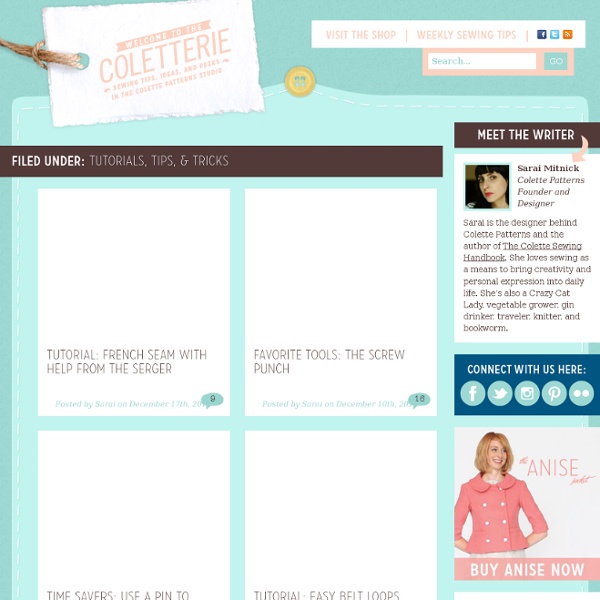



http://www.coletterie.com/category/tutorials-tips-tricks
pattern drafting You need 1 18″ reversible nylon closed zipper2.5 yds. of shell fabric, 60″ wide1.5 yds. of liner fabric, 60″ wideCoordinating thread1 roll of kraft paper or pattern-making papper1 tracing wheel On a sheet of kraft paper, draw a straight line about 2″ from the edge along the length. In the middle of this line, mark point 1. 2 from 1 = 29″ 3 from 1 = 29″ insatiable need A few weeks ago, I went to Dallas for the wedding of a friend of mine from college, and unsurprisingly, the reception ended up doubling as a mini college reunion. Some of those people I literally hadn’t seen since graduation day. Naturally, the experience got me thinking about the thing I am always thinking about: sewing. (really).
Tejidos confitadas Dyeing with Kids | An Ombre Dyed Pillowcase Tutorial for Sew Mama Sew Logan and I had a lot of fun last week making a video for my latest tutorial: It’s written for kids, and there’s both written instructions with pictures as well as a video, showing how easy it is to ombre dye a pillowcase! Head on over to Sew Mama Sew for the tutorial! Pointe de Col Parfaite "Secret" in this case meaning that after all these years I am finally sharing one of the ways I achieve "As close to perfect as possible" Collar Points on the shirts that I design and sew for my clients. Free Front Or Back Tie Pillowcase Dress Pattern & Tutorial Hello friends! Today I have a front tie or back tie option that I am excited to add to the Fat Quarter Pillowcase Dress collection. Using a front tie is a great way to make a pillowcase dress look a little more formal, and a back tie is a great option for keeping little fingers from untying the bow. You could of course use this idea for any pillowcase dress pattern, and I will explain how to do that as well.
Sew Serendipity: Making Bags: What in the heck is buckram? When I started working on bag designs last year, I thought about what makes a bag useful. One of my biggest pet peeves is a bag that simply doesn't stand up for itself! No wimpy bags for this chick! So, of course, that brings me to the topic of today's post which is buckram. The Technique Zone: Acrylic Paint Transfer Supplies needed: Acrylic dabbers, photocopy of an image, water spritzer bottle, paintbrush, card stock, craft sheet and heat tool (optional) Take the lid off the dabbers and brush the paint onto the card stock, ensure you get a good coverage Take your photocopied image ( remember that you will get a reverse of the image, so don't use bold words), flip it over and place it in the acrylic. Lightly press it down making sure it's smooth and not wrinkled Leave to air dry for at least 15 minutes and then if you wish give it a blast with the heat tool
a simple skirt With spring and summer upon us, it’s time for skirts! And making cotton skirts for girls (or yourself) is so very simple. The concept is nothing new. How to Resize a Pattern No matter how well designed a pattern may be, it cannot fit each individual perfectly. Each human body has its own quirks, and each person has different fitting needs. You may find that you need to enlarge a pattern beyond the sizes available on the sheet, or you might need to shrink it. Perhaps you would like to reduce a woman’s pattern to fit a little girl.